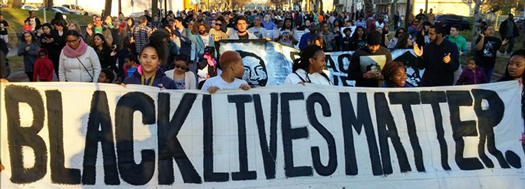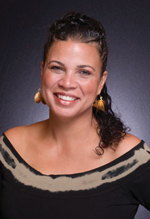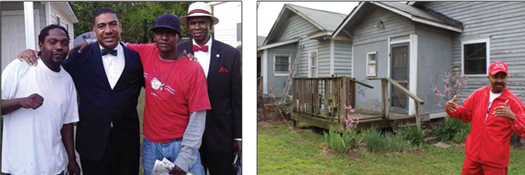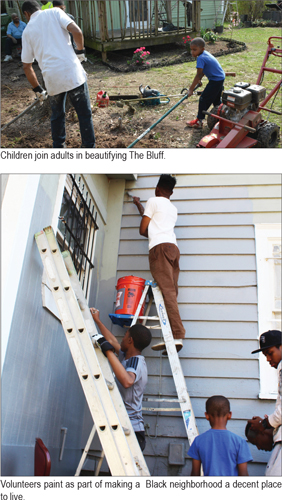By Charlene Muhammad CHARLENEM


A harrowing year for Blacks spawned activism reminiscent of the Black Power struggle and civil rights era combined. Young people took to the streets, challenged political candidates, exposed campus racism and their audacity, courage and energy drew many others to join the uprising.
In 2016, Black youth, faith groups, and online activist organizations like change.org, escalated activity against police brutality and mob attacks, medical genocide, discrimination, low wages, and environmental racism.
Activists and organizations disregarded artificial barriers and found unity in some common agreements to fight against White Supremacy, which reared its ugly head in varied forms. They have opposed the man elected president, Donald J. Trump, and are planning to protest during his Jan. 20 inauguration. But that’s just one issue and one aspect of activism in the closing year.
Black Lives Matter

Dr. Melina Abdullah, Black Lives Matter Los Angeles organizer and chair of the Pan African Studies Department at California State University Los Angeles, said the organization is absolutely engaged in trying to end state-sanctioned police violence against Black people. It’s involved in various legal cases, but the overarching problem is how the existing system oppresses and kills Blacks, she said.
“We really want to back away from the traditional model of policing that really puts our safety in the hands of a system that really despises us, that uses us, and that benefits from injustice meted out towards us,” Dr. Abdullah said. “We’re committed to pushing back from police. We believe in the eventual abolition of policing as we know it, and are reimagining what public safety looks like,” she added.
The outcome of the trial in the police shooting of unarmed Black motorist Walter Scott further underscores why Blacks took to the streets this year. On Dec. 5, Judge Clifton Newman declared a mistrial in the state murder case of Michael Slager, the White former North Charleston. S.C., police officer, who was accused of killing Mr. Scott after a traffic stop for a broken tail light in April 2015.
National protests also erupted over back-to-back police shootings in Baton Rouge, Louisiana and in suburban Minnesota.
Demands for police reform escalated after Baton Rouge police officers Blane Salamoni and Howie Lake II shot Black father Alton Sterling six times in the chest while tackling him to the ground on July 5. An anonymous caller told police he was selling Cds in front of a convenience store, according to media reports.
Calls for justice escalated as did protests after St. Anthony Police Officer Jeronimo Yanez fatally shot police Philando Castile, a Black motorist, on July 6, in Minnesota.
“Twenty-sixteen, in terms of state sanctioned violence, which includes police violence and how it’s been visited upon the Black community, again and again we saw people not getting convicted in the murder of Freddie Gray. We saw non-indictments, where cops were not even being charged for the murders of Black people, and that was the recurring theme of 2016,” said L.A.-based human rights attorney Nana Gyamfi .
Natalie Green, associate campaigner at change.org, an online platform which enables people to start campaigns and mobilize supporters, noted that in 2016 alone, a disproportionate percentage of the 561 people killed by police in 2016 were Black.

And more than 1.2 million people are supporting petitions in a police accountability movement, which includes a petition to change stand-your-ground laws and another to create a national database of police shootings, she said.
Seeking 10,000 Fearless

Justice Or Else! Local Organizing Committees (LOCs) across the country have been working on making Black neighborhoods decent and safe places to live to help alleviate the need for law enforcement in these communities.
“By the will of Allah, and his permission, the LOC’s were quite productive in this year coming off of 10.10.15 (the 20th Anniversary of the Million Man March, with the theme Justice or Else!) Starting with the boycott of Black Friday last year, and continuing the no holiday spending going all the way into January,” said Student Minister Jeffrey Muhammad of Mosque Maryam in Chicago, Ill.
The biggest initiative out of 10.10.15 has been the 10,000 Fearless, he said. “The biggest promoter of that has been Student Minister Sharrieff out of Atlanta, and all of his exploits have been highlighted in the Final Call newspaper, and I believe there are over 70 chapters of the 10,000 Fearless in America at this point,” Jeffrey Muhammad stated.
The chapters consist of members who are not in the Nation of Islam. They include Christians and members of other denominations, people who attend no places of worship, street organizations, and concerned men and women who heard the Honorable Minister Louis Farrakhan’s call to stand between the gangs and guns and rebuild wasted cities.

On April 16, more than 60 cities participated in neighborhood clean ups at the same time each month on “Red, Black, Clean and Green Day.”
In Chicago, Justice Or Else! And other organizations helped to bring a United Nations official to Chicago, and ultimately the UN agreed publicly that Blacks were owed reparations for the trans-Atlantic slave trade, he said.
Across the country, Justice Or Else! Local Organizing Committees have participated in protests, marches and rallies and helped lead the way and protect demonstrators in Louisiana, L.A., St. Louis, Chicago, New Orleans, and Baltimore.
In fact, Jeffrey Muhammad stated, Student Minister Tony Muhammad in Los Angeles and Student Minister Willie Muhammad in New Orleans have received a positive reception from street organizations in promoting conflict resolution.
The New Orleans Peacekeepers is the name of his city’s conflict resolution effort, which has been taking place since 2011, said Willie Muhammad. The name stems from work with Dennis Muhammad and the Peacekeepers, another peace promoting group.
Since then, the effort has resolved 39 conflicts, he stated. Those range from simple misunderstandings to an actual shooting.
“Out of all the conflicts that we’ve done, we have not had any flare ups afterwards,” Willie Muhammad stated.
In Baltimore, Student Minister Carlos Muhammad helped to forge peace between Pastor Jamal Bryant and young men in a West Baltimore neighborhood, who had expressed displeasure and his going into their area, Jeffrey Muhammad said.
“It was our Muslim brother who brought two Christians together and brought peace, so all across the country, Bro. Corey in Charlotte … Bro. Robert in Houston … He’s been very active and spoke at Alton Sterling’s funeral, and lit the place up with the words he spoke from the Minister,” he continued.
“We’re in 90 cities as a matter of fact. So what we want to do is all of the cities where there are mosques, study groups and study circles, we want to have or our goal is to put a 10,000 Fearless center in every city in 2017. And we want to set up Conflict Resolution Centers in all of the cities as well because that’s what the Honorable Minister Louis Farrakhan wanted,” said Abdul Sharrieff Muhammad, interim director of the 10,000 Fearless.
“The different programs that we have like feeding the homeless, clothing the homeless and after school programs for our girls and boys in different centers that’s what we want in centers all over this country. We want to set up the patrols so we can secure our own communities. We started it in most of the cities but we want to put it in every city. Everything that the Honorable Minister Louis Farrakhan asked us to do pertaining to the 10K Fearless centers for male and females that’s what we intend to do by the grace of God,” said Mr. Sharrieff Muhammad, a Nation of Islam student minister and head of the 10,000 Fearless in Atlanta.
Protests against unsafe vaccinations
The Nation of Islam and activists with CDC Truth, “Demanding Truth, Transparency and Freedom,” held a mass demonstration in front of the Centers for Disease Control headquarters in Atlanta in mid-October. They want the CDC to allow whistleblower Dr. William Thompson to testify before Congress about data which he says shows a link between the MMR vaccine and autism.
While helping to spearhead protests against the CDC, Tony Muhammad raised awareness about the dangers of vaccines and an alleged CDC coverup about negative impact of the vaccine on Blacks, particularly Black boys, during a national tour. He also promoted the documentary, “Vaxxed: From Coverup to Catastrophe,” during his tour.
So far he’s taken the truth about vaccines to 30 cities, he said. “The awareness of the Black community as it relates to vaccines is rising like we’ve never seen before … Our people are beginning to know,” he stated.
Since the CDC protests, another group, CDC Scientists Preserving Integrity, Diligence and Ethics in Research (dubbed CDC SPIDER), came forward a day after the protest and admitted the government agency has been compromised, Tony Muhammad said.
“It’s bringing up courage and a movement is beginning to start, and it looks like the vaccine movement is joining also with other movements for clean air, clean water, those movements against Monsanto are also coming together to form one movement,” he said. In April 2017, the movement plans to protest the National Press Club in Washington, D.C. for media silence on these and other environmental threats, according to Tony Muhammad.
Many who feel helpless and unable to hit the streets for protests find hope in Minister Farrakhan’s call for economic withdrawal and actions like the Black Dollars Matter Challenge, a brainchild of Student Captain Dennis Muhammad, founder of the Peacekeepers.
Consumers spend at least $20 with a Black business, and then ask for $1 back. That $1 can be given to the Economic Blueprint, which safeguards the money in a national treasury with donations used to purchase land and finance projects to benefit the Black community. The Economic Blueprint is another initiative called for by Min. Farrakhan. But that $1 doesn’t have to go to www.economicblueprint.org. “Give it to a Black organization that’s uplifting your people, or, give it to some Black homeless person,” Tony Muhammad said.
Standing With Standing Rock
In April, Native Americans escalated their battle to protect their land and water from the Dakota Access Pipeline (DAPL), with more than 15,000 people, some from different parts of the world, traveling to stand with the Standing Rock Sioux Tribe.
After vicious attacks on demonstrators–selfdescribed “water protectors”– by Morton County Police and security forces hired by DAPL, the tribe claimed a victory after President Barack Obama halted construction of the pipeline that would cross under Lake Oahe. Activists say the pipeline could endanger a critical fresh water source. But, the fight against the 1,172 mile $3.8 billion pipeline’s builders isn’t over as Energy Transfer Partners dismissed the decision as partisan politics and vowed to keep building.
According to Ladonna Brave Bull Allard, a Standing Rock Sioux historian and founder of the Sacred Stone Camp, established in April, the number of camp resident are now fewer than 600 people. The weather for those unfamiliar with cold in Dakota lands was too much for people’s safety, she said.
But supporters are still there and are in prayer every day, she said. We fight on with all of the power, support and love they have received from the people, she said.
“Where do we go from here? As we made a commitment to stand with everybody and every state and every nation who is fighting these same issues, we must all stand together,” Ms. Allard stated. “This is not the end. It is only the beginning. I was so honored to sit with the Amazon people and talk about the Amazon River. We stand with them.”
“I am so empowered that we talked with the people from New York. We stand with them. Philadelphia, Michigan, all of Canada as they are standing and fighting for water, we stand with them,” she said.
“We cannot go back. This is not about Standing Rock anymore. It is about the people, and so we must do everything in our power to stand with everybody who is standing everywhere,” Ms. Allard told The Final Call.












